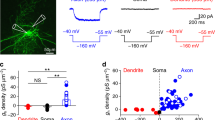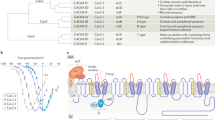Abstract
SEVERAL types of postsynaptic inhibition have been observed in molluscan neurones; in Aplysia, the most common is a rapidly decaying inhibitory postsynaptic potential (IPSP) with pharmacological characteristics which have been describad by Taue and Gerschenfeld1. In their study of the role of acetylcholine (ACh) in the nervous system of Aplysia, they noted that cells receiving this inhibitory input are hyperpolarized by ionophoretic injection of ACh, and that both the ACh potential and the IPSP are blocked by d-tubocurarine. They also demonstrated that the polarization at which the ACh potential reverses is similar to that of the equilibrium potential for the IPSP, implying that the two potentials have the same underlying ionic mechanism. They concluded, on the basis of these and other data, that these IPSPs are cholinergic. Further work on similar cholinergic IPSPs in the land snail indicated that these potentials are the result of changes in the permeability of the postsynaptic membrane to chloride2 with some possible contribution from potassium ions3.
This is a preview of subscription content, access via your institution
Access options
Subscribe to this journal
Receive 51 print issues and online access
$199.00 per year
only $3.90 per issue
Buy this article
- Purchase on Springer Link
- Instant access to full article PDF
Prices may be subject to local taxes which are calculated during checkout
Similar content being viewed by others
References
Tauc, L., and Gerschenfeld, H. M., J. Neurophysiol., 25, 236 (1962).
Chiarandini, D. J., and Gerschenfeld, H. M., Science, 156, 1595 (1967).
Kerkut, G. A., and Thomas, R. C., Comp. Biochem. Physiol., 8, 39 (1963); ibid., 11, 199 (1964).
Tauc, L., Arch. ital. Biol., 96, 78 (1958).
Waziri, R., Frazier, W. T., and Kandel, E. R., Twenty-third Intern. Cong. Physiol. Sciences, 910 (1965).
Bruner, J., and Tauc, L., Symp. Soc. Exp. Biol., 20, 457 (1965).
Gerschenfeld, H. M., and Chiarandini, D. J., J. Neurophysiol., 28, 710 (1965).
Tauc, L., J. Gen. Physiol., 45, 1077 (1962).
Katz, B., and Miledi, R., Proc. Roy. Soc., B, 161, 496 (1965).
Author information
Authors and Affiliations
Rights and permissions
About this article
Cite this article
KEHOE, J. Pharmacological Characteristics and Ionic Bases of a Two Component Postsynaptic Inhibition. Nature 215, 1503–1505 (1967). https://doi.org/10.1038/2151503b0
Received:
Issue Date:
DOI: https://doi.org/10.1038/2151503b0
This article is cited by
-
Modulation of Synaptic Reactions of the “Nociceptive” Neurons in the Cat Cortex upon Stimulation of the Periaqueductal Gray and Application of Some Pharmacological Agents
Neurophysiology (2017)
-
Effects of intracellular injection of chloride ions on inhibitory postsynaptic potentials and postburst hyperpolarization in cat sensorimotor cortex neurons
Neurophysiology (1986)
-
Two kinds of cholinoreceptors on the membrane of the completely isolated identified Planorbarius corneus neurone
Nature (1976)
-
Different sensitivities to ethanol of three early transient voltage clamp currents of aplysia neurons
Pfl�gers Archiv European Journal of Physiology (1974)
-
Diphasic synaptic potentials and prolonged poststimulus hyperpolarization in Helix pomatia neurons
Neurophysiology (1974)
Comments
By submitting a comment you agree to abide by our Terms and Community Guidelines. If you find something abusive or that does not comply with our terms or guidelines please flag it as inappropriate.



